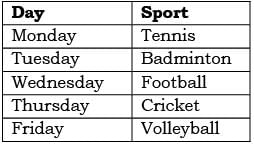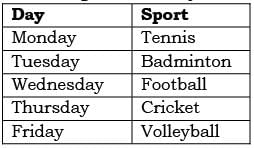UPSC CSE Prelims Paper 2 Practice Test - 10 - UPSC MCQ
30 Questions MCQ Test - UPSC CSE Prelims Paper 2 Practice Test - 10
Two boys, who study in a school, start walking to their homes from their school at 1 pm. The first boy, whose home is 5 km away from the school walks at a speed of 5 km/hr and the second boy whose home is 8 km away from the school walks at a speed of 6 km/hr. If their homes are in directly opposite directions, what will be the distance between the two boys at 2:10 pm?
Number of mobiles produced by Xiaomi Market share of bikes for year 2018
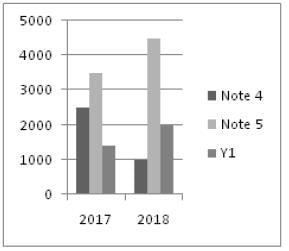

If Xiaomi Company wants all its Y1 which are produced in 2017 and 2018 to be sold then what should have been the number of Y1 produced in 2018?


| 1 Crore+ students have signed up on EduRev. Have you? Download the App |
Number of mobiles produced by Xiaomi Market share of bikes for year 2018
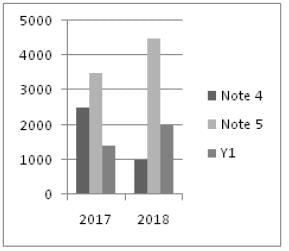

If in 2018 Note 3 accounts for 8% of market share, what percent of others category does it account for?


Lakshman went 15 km to the west from his house, then turned left and walked 20 km. He then turned East and walked 25 km and finally turning left covered 20 km. How far is he now from his house?
A car is stolen at 2:30 pm and the thief runs away with the car driving at a speed of 60 km/hr. The owner discovers about the theft at 3 pm. He sets off in another car at a speed of 75 km/hr. If the owner drives on the correct path directly behind the thief, he would be able to catch the thief at:
Number of mobiles produced by Xiaomi Market share of bikes for year 2018


If in 2019 Galaxy 9 enters the market and is able to capture 5% of the 50,000 market then what is the percentage difference between market share of Galaxy 9 and Note 4? (Assuming percentage market share of Xiaomi mobiles and others is the same as in the previous year)
Number of mobiles produced by Xiaomi Market share of bikes for year 2018


If the market share of others remains the same, what is the total number of One plus mobiles sold in 2018, if One plus enters as a new player in market in 2018 and has the same market share as Xiaomi?
Directions: Symbols @, %, #, $, © are used with different meanings as explained below: ‘P @ Q’ means ‘P is not greater than Q’. ‘P % Q’ means ‘P is neither greater than nor equal to Q’. ‘P # Q’ means ‘P is neither smaller than nor equal to Q’. ‘P $ Q’ means ‘P is neither smaller than nor greater than Q’. ‘P © Q’ means ‘P is not smaller than Q’.
Three statements showing relationships have been given, which are followed by two conclusions (1) and (2). Assuming that the given statements are true, find out which conclusions(s) is/are definitely true.
Q. Statements: J # P, P @ B, B % H.
Conclusions:
1. J @ B
2. J % H
A class contains N students, having roll numbers 1,2,3....N. On a particular day only 50 students turn up for the class. The average of the roll numbers of the students present on that day is 38. A teacher punishes two students and sends them out of the class. The average of the roll numbers of the students who are left in the class drops to 37.5. Choose the correct statement from the options given below.
Expenditures of a Company (in Lakh Rupees) per Annum Over the given Years
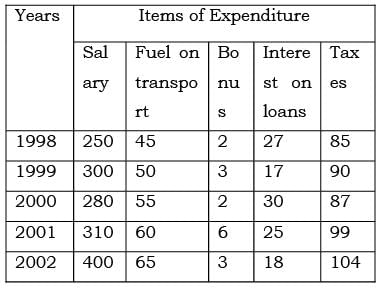
The total amount of bonus paid by the company during the given period is approximately what percent of the total amount of salary paid during this period?
Expenditures of a Company (in Lakh Rupees) per Annum Over the given Years

The ratio between the total expenditure on Taxes for all the years and the total expenditure on Fuel and Transport for all the years respectively is approximate?
Directions for: Examine the information given in the following paragraph and answer the items there follow:
A school is celebrating Sport week in which five games viz. Cricket, Badminton, Tennis, Football and Volleyball are to be held in five different days in a week from Monday to Friday. Only one sport can be played on each day. Cricket cannot be played on Tuesday. Players for Badminton is available only on Tuesday. Volleyball is played immediately after the day of Cricket. Football has to played immediately before the day of Cricket.
Q. Which sport is to be played on Monday?
Directions for: Examine the information given in the following paragraph and answer the items there follow:
A school is celebrating Sport week in which five games viz. Cricket, Badminton, Tennis, Football and Volleyball are to be held in five different days in a week from Monday to Friday. Only one sport can be played on each day. Cricket cannot be played on Tuesday. Players for Badminton is available only on Tuesday. Volleyball is played immediately after the day of Cricket. Football has to played immediately before the day of Cricket.
Q. Which sport is scheduled between Tennis and Football?
Five years ago, the average age of a family, which consisted of three members, was 27 years. The family now consists of four members as a baby was born recently. The current average age of the family is 25 years. How many years ago was the baby born?
Direction: The total annual CO2 emissions from various sectors are 8 mm. In the Pie Chart given below, the percentage contribution to CO2 emissions from various sectors is indicated.
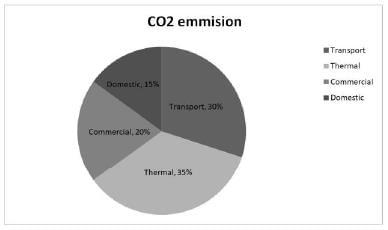
Q. Which of the following sectors together emit 4 mm of CO2 every year?
Directions for: Examine the information given in the following paragraph and answer the items there follow:
A school is celebrating Sport week in which five games viz. Cricket, Badminton, Tennis, Football and Volleyball are to be held in five different days in a week from Monday to Friday. Only one sport can be played on each day. Cricket cannot be played on Tuesday. Players for Badminton is available only on Tuesday. Volleyball is played immediately after the day of Cricket. Football has to played immediately before the day of Cricket.
Q. Which sport is the last one in the week?
In a group of 20 children, two children have hundred marbles each and three do not possess any marbles. The average number of marbles with the rest of the children is 40. What is the average number of marbles with the group of children?
Direction: The total annual CO2 emissions from various sectors are 8 mm. In the Pie Chart given below, the percentage contribution to CO2 emissions from various sectors is indicated.

Q. Which of the following sectors have emission difference of 0.8 mm between them?
If = stands for ÷; + stands for -; - stands for +; × stands for =; ÷ stands for ×; which of the following is true?
Read the information given below carefully and answer the following question.
The whole biosphere, like the individual organisms that live inside it, exists in a chemically dynamic state. In this homeostatic system, a great number of organic compounds are synthesized, transformed, and decomposed continuously; together, these processes constitute the major parts of the carbon cycle. For the smooth operation of this cycle, degradation is just as important as synthesis: the green plants produce great quantities of polymers, such as cellulose, and innumerable other compounds like alkaloids, terpenes, and flavonoids, that green plants cannot use as sources of energy during respiration. The release of the carbon in these compounds for recycling depends almost entirely on the action of both aerobic and anaerobic bacteria and certain types of fungi. Some bacteria and fungi possess the unique and extremely important biochemical asset of being able to catalyse the oxidation of numerous inert products, thereby initiating reaction sequences that produce carbon dioxide and so return much carbon to a form that actively enters into life cycles once again.
Q. The passage contains information that would answer which of the following questions about the carbon cycle?
1. What are some of the compounds that are broken down in the carbon cycle?
2. Why are some compounds that are involved in the carbon cycle less reactive than others? 3. What role do bacteria and fungi play in the carbon cycle?
Read the information given below carefully and answer the following question.
The whole biosphere, like the individual organisms that live inside it, exists in a chemically dynamic state. In this homeostatic system, a great number of organic compounds are synthesized, transformed, and decomposed continuously; together, these processes constitute the major parts of the carbon cycle. For the smooth operation of this cycle, degradation is just as important as synthesis: the green plants produce great quantities of polymers, such as cellulose, and innumerable other compounds like alkaloids, terpenes, and flavonoids, that green plants cannot use as sources of energy during respiration. The release of the carbon in these compounds for recycling depends almost entirely on the action of both aerobic and anaerobic bacteria and certain types of fungi. Some bacteria and fungi possess the unique and extremely important biochemical asset of being able to catalyse the oxidation of numerous inert products, thereby initiating reaction sequences that produce carbon dioxide and so return much carbon to a form that actively enters into life cycles once again.
Q. The author implies that which of the following is the primary reason that degradation is as important as synthesis to the smooth operation of the carbon cycle?
Based on the following bar graph. (Number of Industrial Townships in 1978 is 160000)
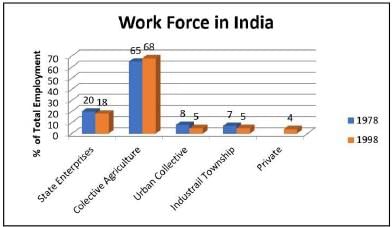
Which was the first year when people were employed in private enterprises?
Based on the following bar graph. (Number of Industrial Townships in 1978 is 160000)
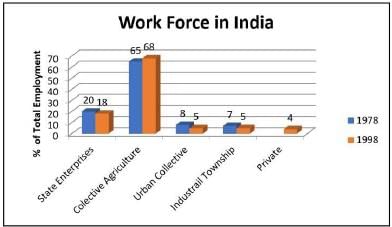
If it is known that the total work force in India increases at a simple rate of 10% per annum, then by what per cent does the number of people employed in the Urban Collectives change?
Directions
A book is divided into 6 chapters. The following pie chart denotes the percentage of the total pages devoted to each chapter.

If Chapter 1 contains 60 pages, the number of pages in chapter 5 is?
Directions
A book is divided into 6 chapters. The following pie chart denotes the percentage of the total pages devoted to each chapter.

The central angle for Chapter 6 is x degrees more than that of chapter 5. The value of x is
Raj travelled from a point X straight to Y at a distance of 80 metres He turned right and walked 50 metres then again turned right and walked 70 metres Finally he turned right and walked 50 metres How far is he from the starting point ____________.
In the Venn diagram given below, what is the total number of singers who are only painters or only dancers but not both painter as well as dancer.
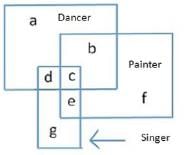
The table represent the percentage expenditure of the income of A, B, C, D, E and F on different items.

If the annual income of B and C are ₹2,16,000 and ₹2,64,000 respectively, what is the difference between the amount spent by them on transport?
The table represent the percentage expenditure of the income of A, B, C, D, E and F on different items.

If the amount of money spent on food by C and D are ₹72000 and ₹86400 respectively, then the annual income of C is what percentage of the annual income of D?
The table represent the percentage expenditure of the income of A, B, C, D, E and F on different items.

The percentage of amount of money spent by E on entertainment is what percentage of the amount of money spent by F on transport?


